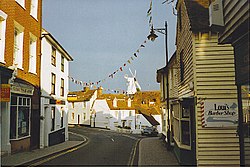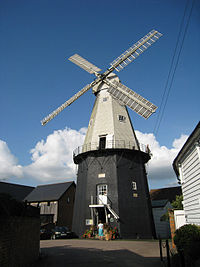Cranbrook
| Cranbrook | |
| Kent | |
|---|---|
 Stone Street, Cranbrook | |
| Location | |
| Grid reference: | TQ775365 |
| Location: | 51°6’3"N, 0°32’4"E |
| Data | |
| Population: | 5,358 |
| Post town: | Cranbrook |
| Postcode: | TN17 |
| Dialling code: | 01580 |
| Local Government | |
| Council: | Tunbridge Wells |
| Parliamentary constituency: |
Maidstone and The Weald |
Cranbrook is a small town in Kent. It is an ancient chartered market town, granted a charter in 1290 by Archbishop Peckham, allowing it to hold a market in the High Street. The smaller villages of Swattenden, Colliers Green and Hartley lie within the parish. Baker's Cross is on the outskirts of the town.
Cranbrook is home to around 7,000 folk. Their nearest railway station is Staplehurst, 5 miles to the north. Cranbrook station served the town from 1892 to 1961.
Contents
Name
The place name Cranbrook derives from Old English cran broc, meaning "Crane Brook". Spelling of the place name has evolved over the centuries from Cranebroca (c. 1100); by 1226 it was recorded as Cranebroc, then Cranebrok. By 1610 the name had become Cranbrooke, which evolved into the current spelling.[1][2]
History
In mediæval times, Cranbrook was a centre of the Wealden cloth industry; and iron-making was carried on at Bedgebury on the River Teise. The church here was dedicated to St Dunstan. Called the "Cathedral of the Weald",[3] its 74 feet-high tower, completed in 1425, has a wooden figure of Father Time and his scythe on the south face. It also contains the prototype for the Big Ben clock in London.[3]
H E Bates, who knew Cranbrook well, wrote rather cuttingly:
| “ | "Cranbrook is a village giving the impression of trying to remember what once made it important." | ” |
Mills
Cranbrook had a number of watermills and windmills over the centuries. There were about seventeen watermills around Cranbrook, all on tributaries of the River Beult.
There were four windmills in Cranbrook over the centuries, one of which survives today.
- Windmill Hill: mill recorded 1736; possibly a smock mill[4]
- Saint's Hill: recorded 1769, 1 mile 5 furlongs northeast of the church.[4]
- Cranbrook Common: a smock mill with common sails, recorded 1858 and 1872. It last worked in 1876 and was demolished in 1902. It stood 1¾ miles north of the church.[4]
- Union Mill: Still standing and in working order. Built in 1814, run by the Russell family for 128 years, then sold to the council. It stands ¼ mile southeast of the church.[4]
Big Society and entertainment
The Queens Hall Theatre, part of Cranbrook School, sponsors many theatre groups, including the Cambridge Footlights and Cranbrook Opera and Dramatic Society (CODS). The Showtimers pantomime group produces an annual show.
During the 1800s, a group of artists who called themselves "The Cranbrook Colony", was located here.
The Cranbrook Town Band, founded in the 1920s, is a British-style brass band, which performs regular concerts in the Queens Hall, St Dunstan's Church, and around Kent.
Cranbrook is raising funds to build a new Community Centre by 2012.[5]
Trivia
"Cranbrook" is the name of a hymn tune written by Canterbury cobbler Thomas Clark around 1805, and later used as a tune for the Christmas hymn "While Shepherds Watched Their Flocks". The tune later became associated with the Yorkshire song "On Ilkla Moor Baht 'at".[6]
Outside links
- Official Cranbrook Town website
- History of Cranbrook (2008), Cranbrook Town
- Cranbrook Operatic and Dramatic Society
- St. Dunstan's Parish Church
- Cranbrook School (incl. Queens Hall Theatre)
- Cranbrook Squash Club
- Cranbrook Town Band
- Cranbrook Film Society
- Cranbrook Symphony Orchestra
- Cranbrook Union Mill site
References
- ↑ The Place Names of Kent, Judith Glover ISBN 0-905270-61-4
- ↑ The Origin of English Place Names, P.H.Reaney ISBN 0-7100-2010-4
- ↑ 3.0 3.1 Cranbrook A Wealden Town, C.C.R.Pile (1955)
- ↑ 4.0 4.1 4.2 4.3 Coles Finch, William (1933). Watermills and Windmills. London: C W Daniel Company. pp. 188–91.
- ↑ "The Cranbrook Weald Centre Project". http://www.cranbrookwealdcentre.org. Retrieved 2009-08-01.
- ↑ "While Shepherds Watched". http://www.msgr.ca/msgr-2/on_ilkley_moor_bar_tat.htm. Retrieved 2008-08-07.
